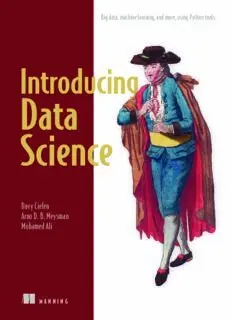Table Of ContentBig data, machine learning, and more, using Python tools
Davy Cielen
Arno D. B. Meysman
Mohamed Ali
M A N N I N G
Introducing Data Science
Introducing
Data Science
BIG DATA, MACHINE LEARNING,
AND MORE, USING PYTHON TOOLS
DAVY CIELEN
ARNO D. B. MEYSMAN
MOHAMED ALI
MANNING
SHELTER ISLAND
For online information and ordering of this and other Manning books, please visit
www.manning.com. The publisher offers discounts on this book when ordered in quantity.
For more information, please contact
Special Sales Department
Manning Publications Co.
20 Baldwin Road
PO Box 761
Shelter Island, NY 11964
Email: orders@manning.com
©2016 by Manning Publications Co. All rights reserved.
No part of this publication may be reproduced, stored in a retrieval system, or transmitted, in
any form or by means electronic, mechanical, photocopying, or otherwise, without prior written
permission of the publisher.
Many of the designations used by manufacturers and sellers to distinguish their products are
claimed as trademarks. Where those designations appear in the book, and Manning
Publications was aware of a trademark claim, the designations have been printed in initial caps
or all caps.
Recognizing the importance of preserving what has been written, it is Manning’s policy to have
the books we publish printed on acid-free paper, and we exert our best efforts to that end.
Recognizing also our responsibility to conserve the resources of our planet, Manning books
are printed on paper that is at least 15 percent recycled and processed without the use of
elemental chlorine.
Manning Publications Co. Development editor: Dan Maharry
20 Baldwin Road Technical development editors: Michael Roberts, Jonathan Thoms
PO Box 761 Copyeditor: Katie Petito
Shelter Island, NY 11964 Proofreader: Alyson Brener
Technical proofreader: Ravishankar Rajagopalan
Typesetter: Dennis Dalinnik
Cover designer: Marija Tudor
ISBN: 9781633430037
Printed in the United States of America
1 2 3 4 5 6 7 8 9 10 – EBM – 21 20 19 18 17 16
brief contents
1 ■ Data science in a big data world 1
2 ■ The data science process 22
3 ■ Machine learning 57
4 ■ Handling large data on a single computer 85
5 ■ First steps in big data 119
6 ■ Join the NoSQL movement 150
7 ■ The rise of graph databases 190
8 ■ Text mining and text analytics 218
9 ■ Data visualization to the end user 253
v
contents
preface xiii
acknowledgments xiv
about this book xvi
about the authors xviii
about the cover illustration xx
1 Data science in a big data world 1
1.1 Benefits and uses of data science and big data 2
1.2 Facets of data 4
Structured data 4 ■ Unstructured data 5
Natural language 5 ■ Machine-generated data 6
Graph-based or network data 7 ■ Audio, image, and video 8
Streaming data 8
1.3 The data science process 8
Setting the research goal 8 ■ Retrieving data 9
Data preparation 9 ■ Data exploration 9
Data modeling or model building 9 ■ Presentation
and automation 9
1.4 The big data ecosystem and data science 10
Distributed file systems 10 ■ Distributed programming
framework 12 ■ Data integration framework 12
vii
viii CONTENTS
Machine learning frameworks 12 ■ NoSQL databases 13
Scheduling tools 14 ■ Benchmarking tools 14
System deployment 14 ■ Service programming 14
Security 14
1.5 An introductory working example of Hadoop 15
1.6 Summary 20
2 The data science process 22
2.1 Overview of the data science process 22
Don’t be a slave to the process 25
2.2 Step 1: Defining research goals and creating
a project charter 25
Spend time understanding the goals and context of your research 26
Create a project charter 26
2.3 Step 2: Retrieving data 27
Start with data stored within the company 28 ■ Don’t be afraid
to shop around 28 ■ Do data quality checks now to prevent
problems later 29
2.4 Step 3: Cleansing, integrating, and transforming data 29
Cleansing data 30 ■ Correct errors as early as possible 36
Combining data from different data sources 37
Transforming data 40
2.5 Step 4: Exploratory data analysis 43
2.6 Step 5: Build the models 48
Model and variable selection 48 ■ Model execution 49
Model diagnostics and model comparison 54
2.7 Step 6: Presenting findings and building applications on
top of them 55
2.8 Summary 56
3 Machine learning 57
3.1 What is machine learning and why should you care
about it? 58
Applications for machine learning in data science 58
Where machine learning is used in the data science process 59
Python tools used in machine learning 60
CONTENTS ix
3.2 The modeling process 62
Engineering features and selecting a model 62 ■ Training
your model 64 ■ Validating a model 64 ■ Predicting
new observations 65
3.3 Types of machine learning 65
Supervised learning 66 ■ Unsupervised learning 72
3.4 Semi-supervised learning 82
3.5 Summary 83
4 Handling large data on a single computer 85
4.1 The problems you face when handling large data 86
4.2 General techniques for handling large volumes of data 87
Choosing the right algorithm 88 ■ Choosing the right data
structure 96 ■ Selecting the right tools 99
4.3 General programming tips for dealing with
large data sets 101
Don’t reinvent the wheel 101 ■ Get the most out of your
hardware 102 ■ Reduce your computing needs 102
4.4 Case study 1: Predicting malicious URLs 103
Step 1: Defining the research goal 104 ■ Step 2: Acquiring
the URL data 104 ■ Step 4: Data exploration 105
Step 5: Model building 106
4.5 Case study 2: Building a recommender system inside
a database 108
Tools and techniques needed 108 ■ Step 1: Research
question 111 ■ Step 3: Data preparation 111
Step 5: Model building 115 ■ Step 6: Presentation
and automation 116
4.6 Summary 118
5 First steps in big data 119
5.1 Distributing data storage and processing with
frameworks 120
Hadoop: a framework for storing and processing large data sets 121
Spark: replacing MapReduce for better performance 123

